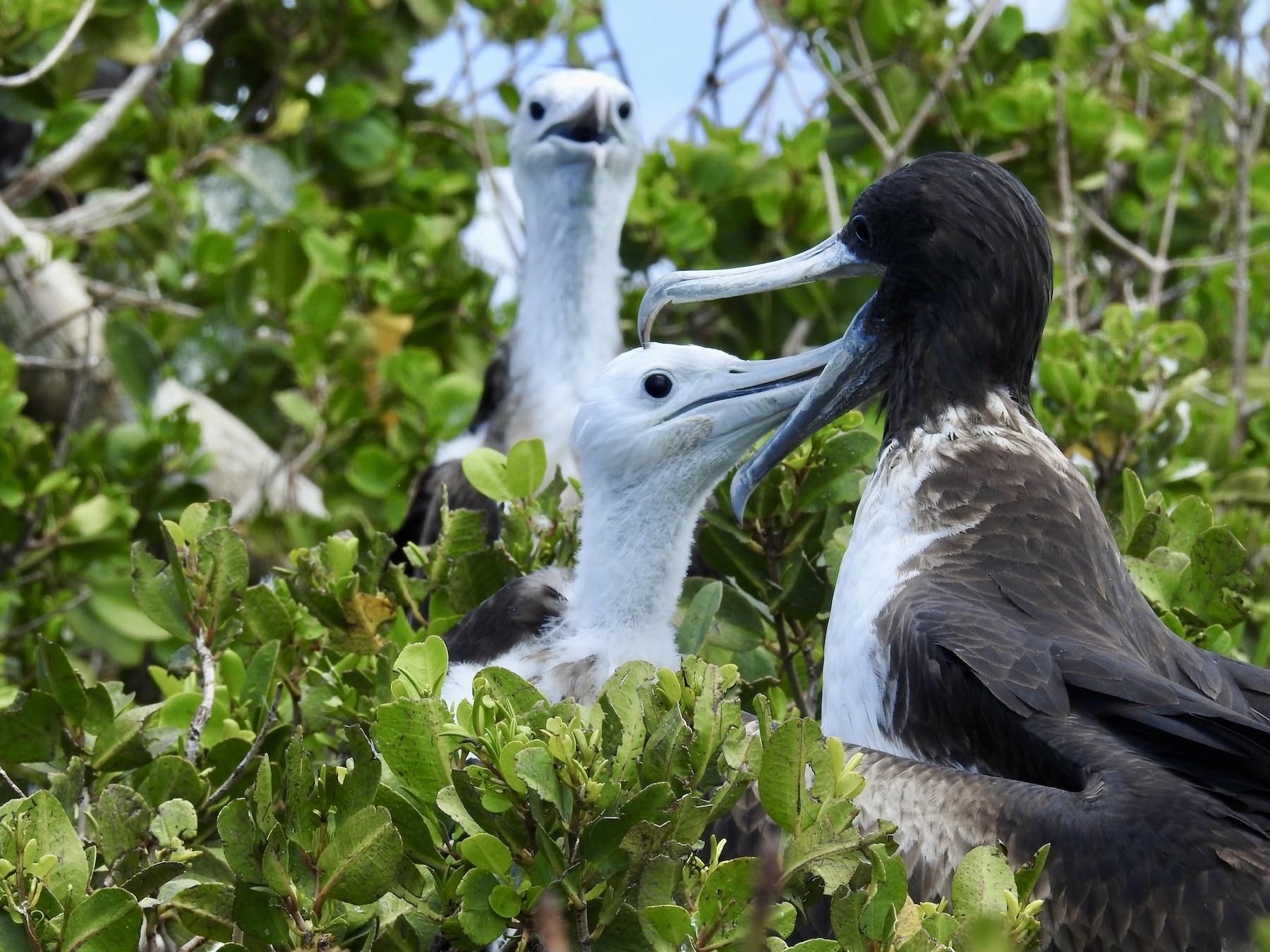
A female frigatebird feeds her chick in Barbuda's Codrington Lagoon National Park/Jennifer Bain
Barbuda's Sanctuary For Frigatebirds
By Jennifer Bain
BARBUDA—The mangroves are teeming with pterodactyl-like frigatebirds nesting awkwardly in the foliage, sunning themselves, languidly feeding their downy white chicks, trying not to trip over each other, and staring at us with looks that range from absolute indifference to fleeting curiosity.
The large seabirds don’t flinch as Clarence Nibbs steers his white and pink converted fishing boat Doublimpact into this precious part of Codrington Lagoon National Park in the Caribbean and cuts the engine. It’s barely May and we’ve been warned that the male Magnificent Frigatebird (Fregata magnificens) — who famously inflates his bright red throat pouch like a balloon during courtship — will likely be long gone.

The male frigatebird during a courtship display is shown in a file photo in Barbuda/Antigua and Barbuda Tourism Authority
Instead, we train our zoom lenses on the chicks, who are born naked and helpless, but quickly grow white down before developing their black and white feathers. Today, we celebrate the female frigatebirds, who are bigger than the males, are identified by their white breasts, and deserve kudos for feeding their chicks for about a year. Adult males, meanwhile, are all black, so it’s easy enough to pinpoint the few that are jostling for space here in what’s trumpeted as the largest frigatebird colony of in the western hemisphere.
A few energetic frigatebirds — smaller than American White Pelicans and larger than Brown Pelicans — float in the clear blue sky overhead, barely flapping their long wings while using their forked tails to steer. These beguiling birds — which famously live in places like the Galapagos an Mexico — may have webbed feet that let them grasp branches, but they also have short legs and apparently don’t walk well. Without waterproof feathers, they also avoid landing on the water and only skim the ocean surface for food.
“Pirates of the sky,” is what the Cornell Lab of Ornithology calls frigatebirds because they harass each other and other birds into regurgitating recently captured food that they then snatch in midair.
“Man-o’-war” is what people here lovingly call the national bird of the twin-island nation of Antigua and Barbuda, which gained independence from Britain in 1981.
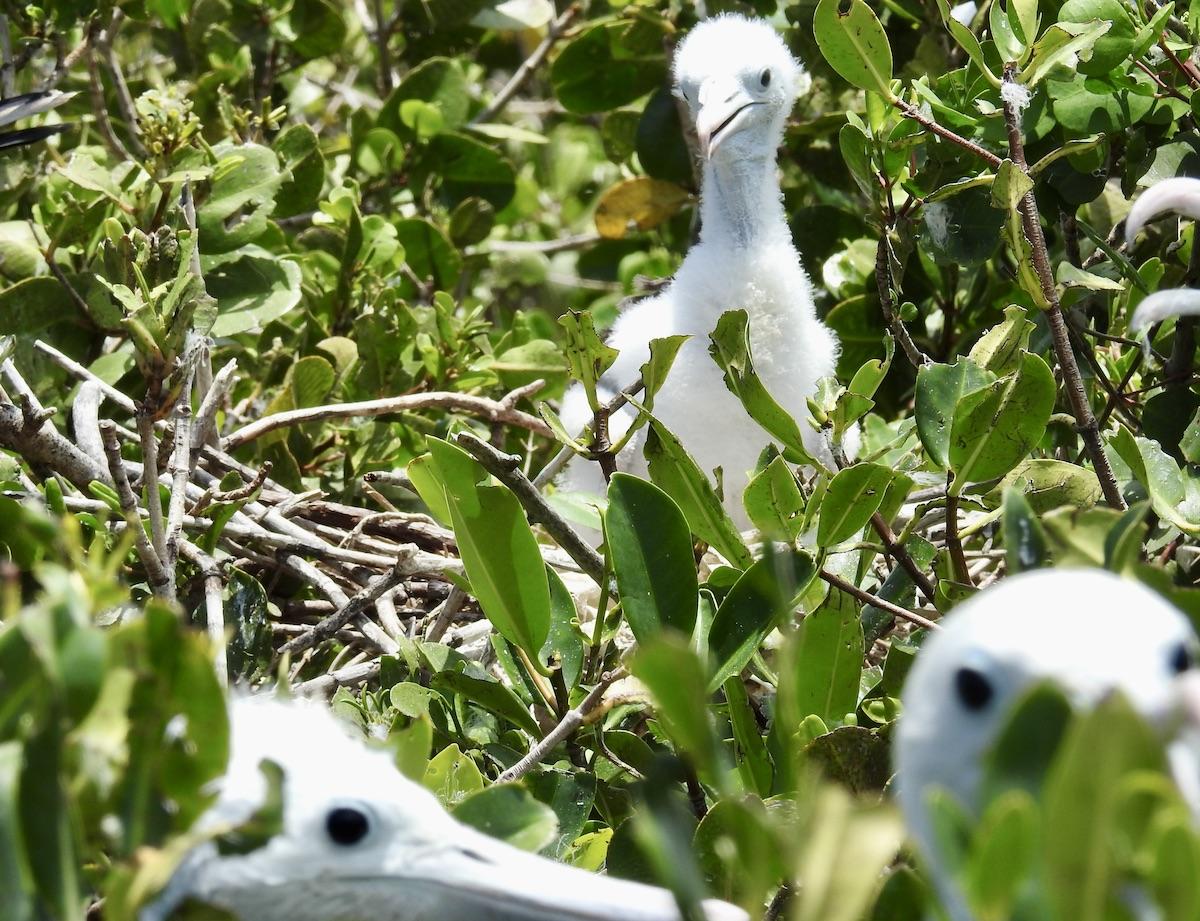
Frigatebird chicks are covered in white down/Jennifer Bain
Barbuda (population 1,500 and pronounced Bar-byew'da) is the remote, less-developed sister island of Antigua (population 100,000, pronounced An-tee'ga). They're 28 miles apart from each other and can be found southeast of Puerto Rico and north of Barbados.
While Antigua is 108 square miles, Barbuda is just 62 square miles. A new global ad campaign sums up its appeal nearly perfectly: “We have one ferry, two flights and ten taxis. We’d love you to come, but please, not all at once.” (But surely there’s room to squeeze in “and one nesting colony of frigatebirds” after the taxis?)
Then again, nobody can say for certain how many frigatebirds live here in Codrington Lagoon, which is a Ramsar site (a wetland of international importance). The figure “2,500 nesting pairs” is widely circulated and Nibbs thinks it’s more like 6,000 pairs “before Irma,” but it’s unclear if and how Hurricane Irma impacted the colony when it battered Barbuda in 2017 and sparked a months-long evacuation.
Globally, the Cornell Lab estimates the population of frigatebirds is 59,000 to 71,000 breeding pairs, but notes that breeding is threatened by urban and resort development, overfishing, hurricanes and predator introductions on nesting islands.
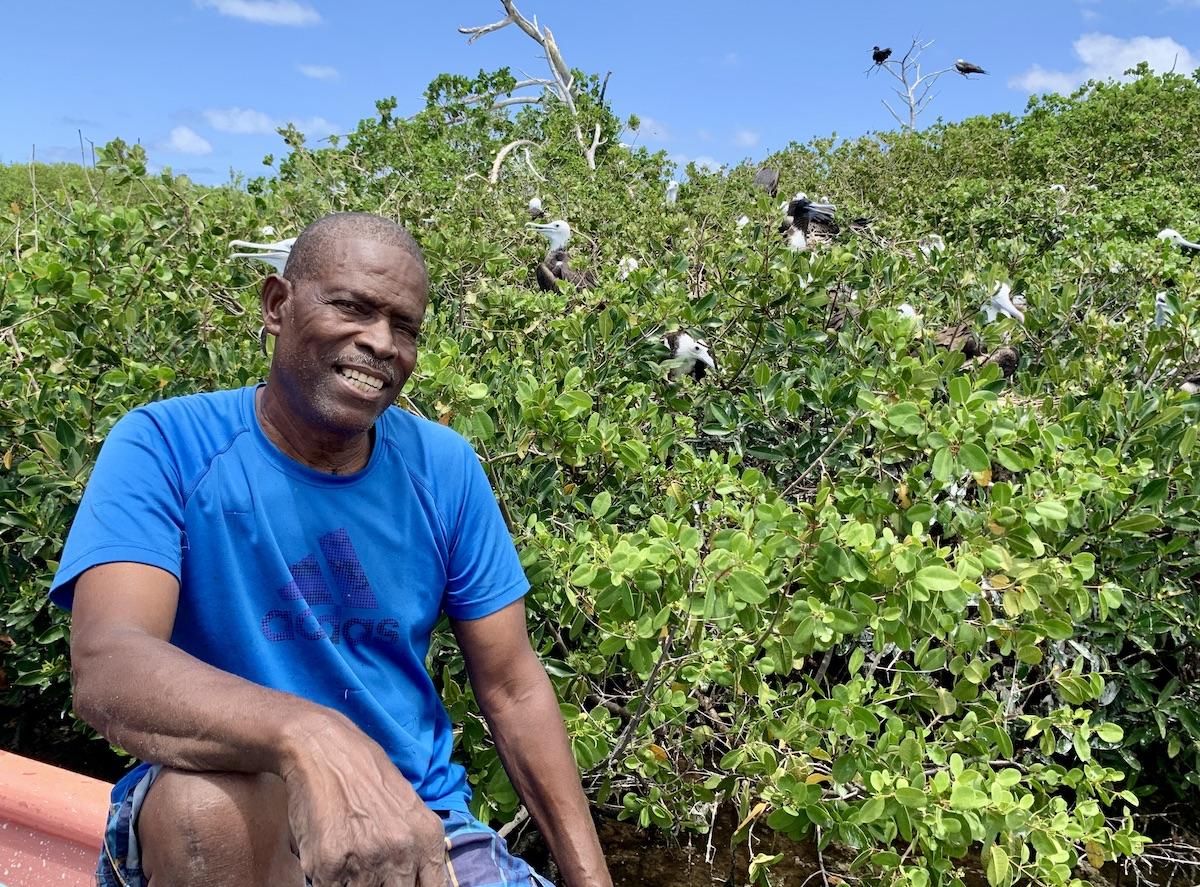
Clarence Nibbs guides visitors to the frigatebird sanctuary in Barbuda/Jennifer Bain
Hurricane Irma did demolish what was once this lagoon’s only entrance, leaving it open to the sea and more attractive to sharks, conch and different species of fish. But frigatebird viewing is still the island’s signature offer. The Barbuda Council collects $5 USD from each visitor at the Fisheries complex by the docks and only allows registered Barbudan boats to take groups out on the lagoon. Tour prices start at $50 for up to four people.
Prime time is between November and April, when you can see the spectacle of males gathering to court females. “They perch in low trees and shrubs with their red throat sac inflated like a balloon and clatter their bills, waving their heads back and forth, and calling at females flying overhead,” reports the Cornell Lab.
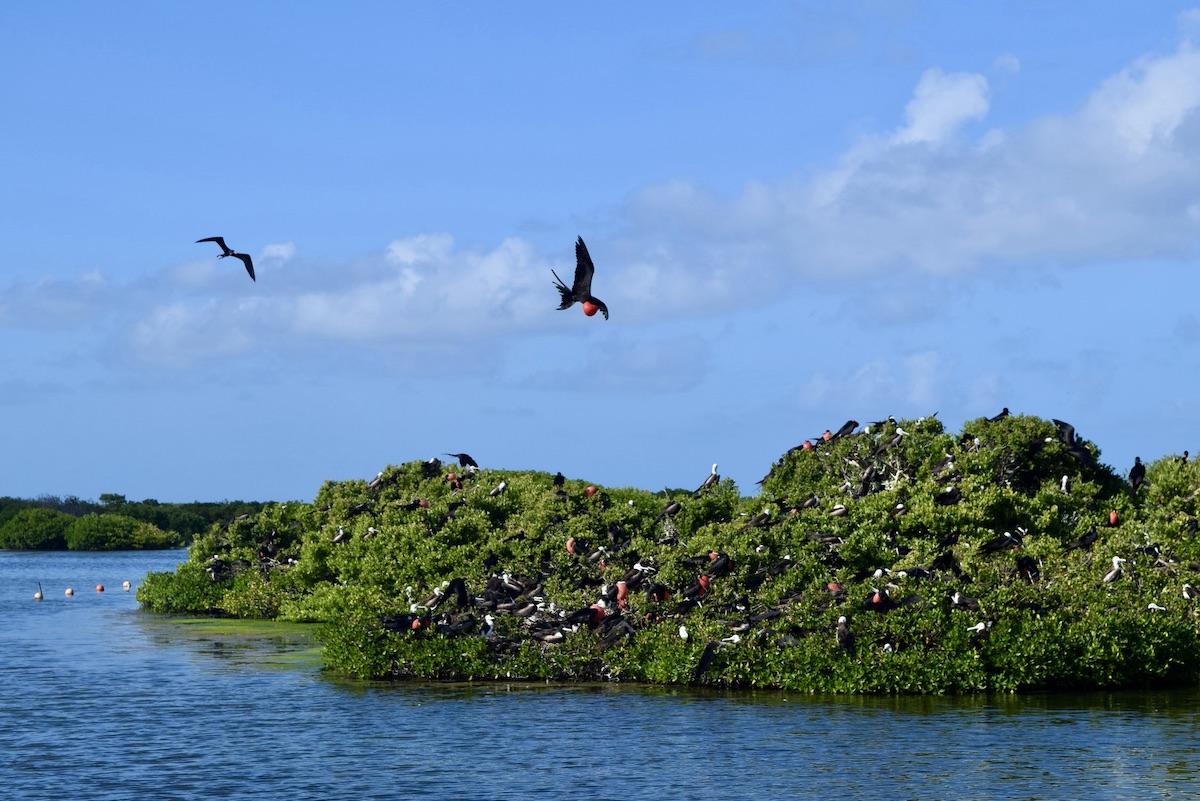
Frigatebirds in flight during mating season in Barbuda/Antigua and Barbuda Tourism Authority
This is when you can, if you are patient, see females choosing a mate and spending two weeks with them building a nest of sticks on the male's display perch. The males also help incubate eggs until the chicks hatch around two months later.
We luck into that precious time after the chicks hatch and before they leave the nest, which the Cornell Lab says happens when they’re about 167 days old. If we come back in a few months, we might get to observe the young birds learning the art of stealing food by practising with sticks.
“The wing span from tip to tip is six feet,” offers Nibbs. “The life span is 40 to 45 years. They fly at an altitude of 6,000 feet.” There don't seem to be any rules about keeping our distance from the colony, and Nibbs allows that there once was a time, decades ago, that Barbudans ate the birds.
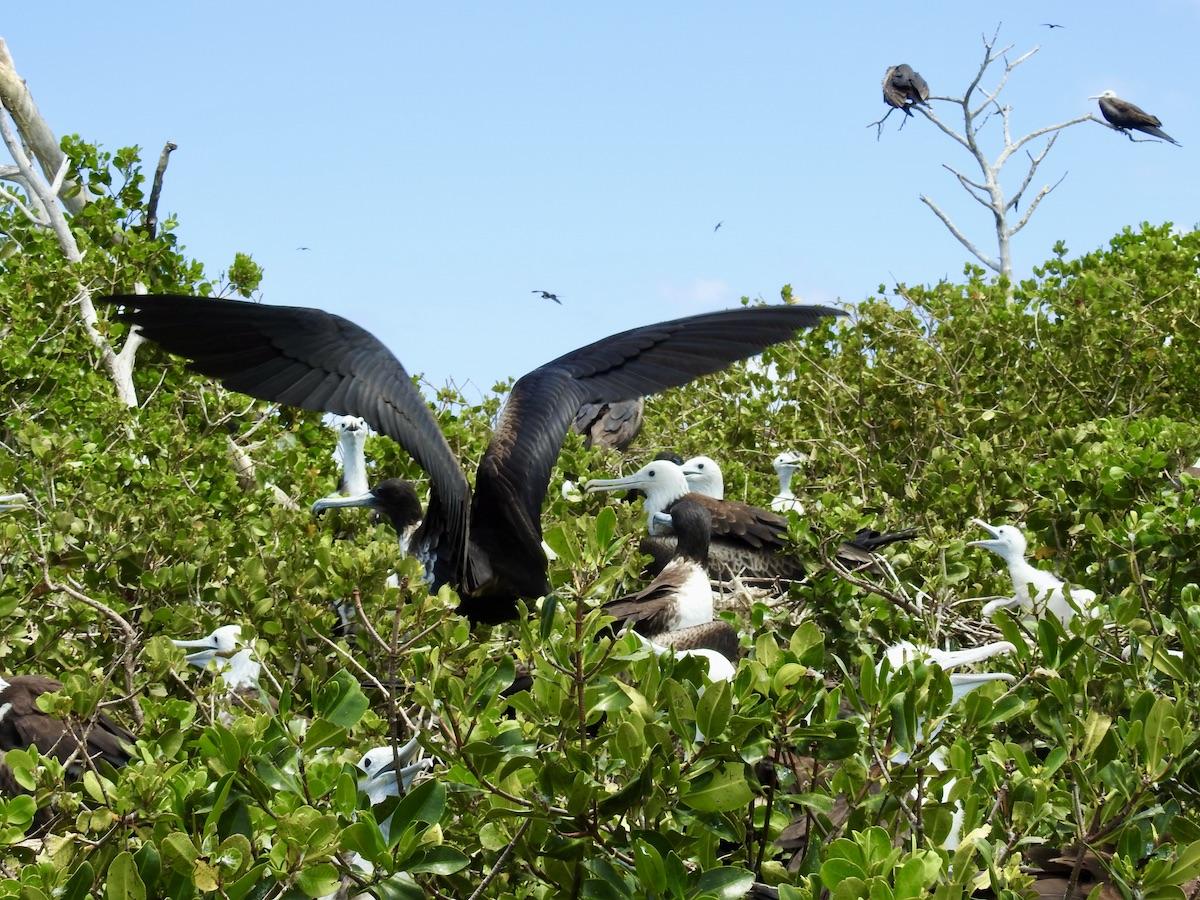
Frigatebirds have large and powerful wings/Jennifer Bain
The Ramsar Convention on Wetlands, in a 2006 listing, describes the Codrington Lagoon as “a relatively well-flushed and healthy ecosystem, comprising mangroves, seagrass beds, algal mats, tidal and mud flats, beaches and coral reefs, supporting a diversity of marine species such as juvenile lobster, reef fish, sea turtles (including endangered Hawksbill and Leatherback turtles), and marine mammals, as well as nesting sea birds.” It notes that in 2004, the year the lagoon was declared a national park, it drew 4,250 visitors to the frigatebird sanctuary.
Barbuda is well aware of the tourism potential of the frigatebirds. In a virtual news conference to unveil its new global ad campaign in March, it noted that while Princess Diana famously vacationed here with her sons (and apparently visited the frigatebirds), there are only about 73 rooms in boutique-style hotels and guest houses to house those who “appreciate a holiday that operates in harmony with nature and the environment.”
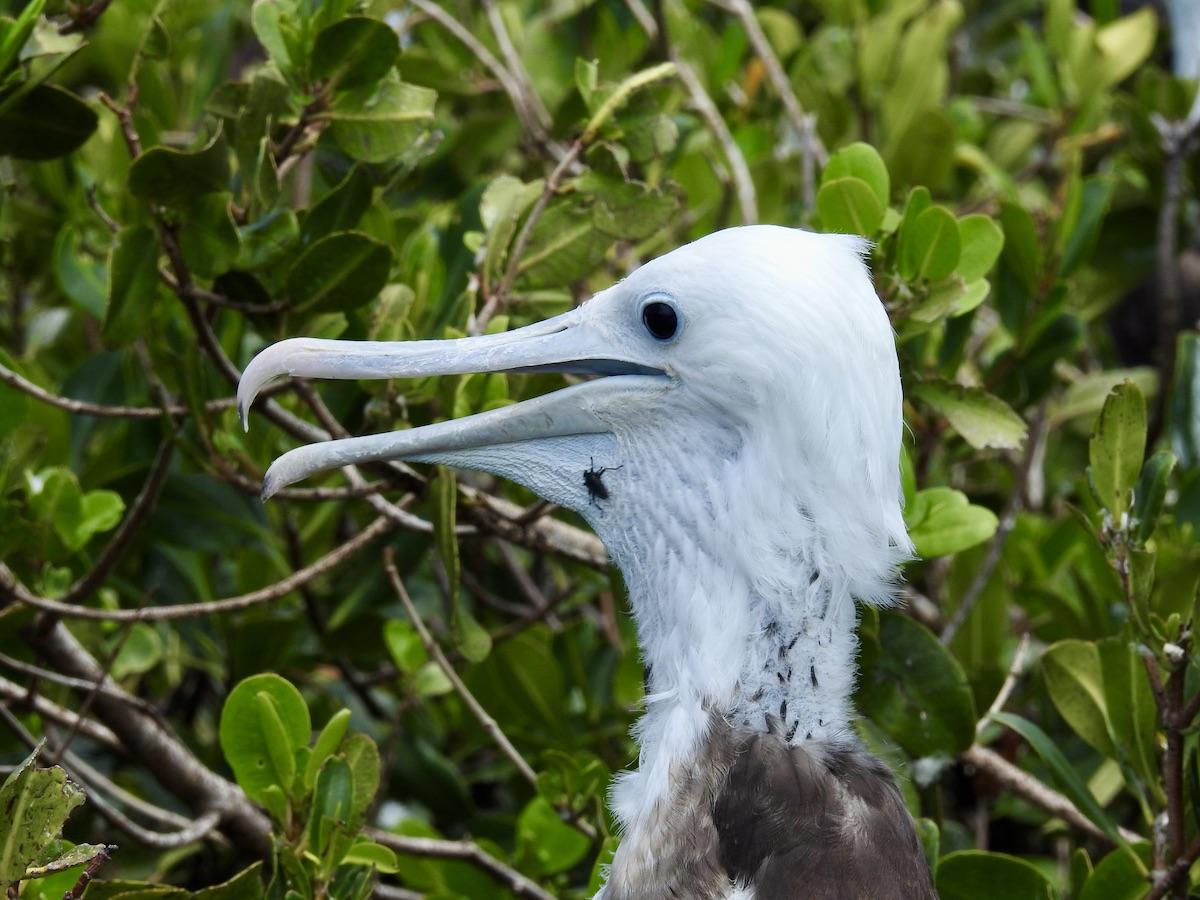
A female frigatebird is seemingly unperturbed by a louse fly (Hippoboscidae)/Jennifer Bain
In 2021, a pandemic year, Barbuda logged 1,574 visits to the frigatebird sanctuary. Between January 1 and March 11 of this year, it had already received 853 visitors. By the time I visited on May 5, that number had reportedly climbed to 1,588 as tourism started to rebound.
Most people visit Barbuda on a whirlwind day trip. The Barbuda Express Ferry eats up 90 minutes of precious time each way, and CalvinAir Helicopters is a decadent option for those in a hurray. I take a 15-minute SVG Air charter on a nine-seat B2N Islander plane, arriving at 8 a.m. and leaving by 3 p.m. That's only enough time for a taste of the island.
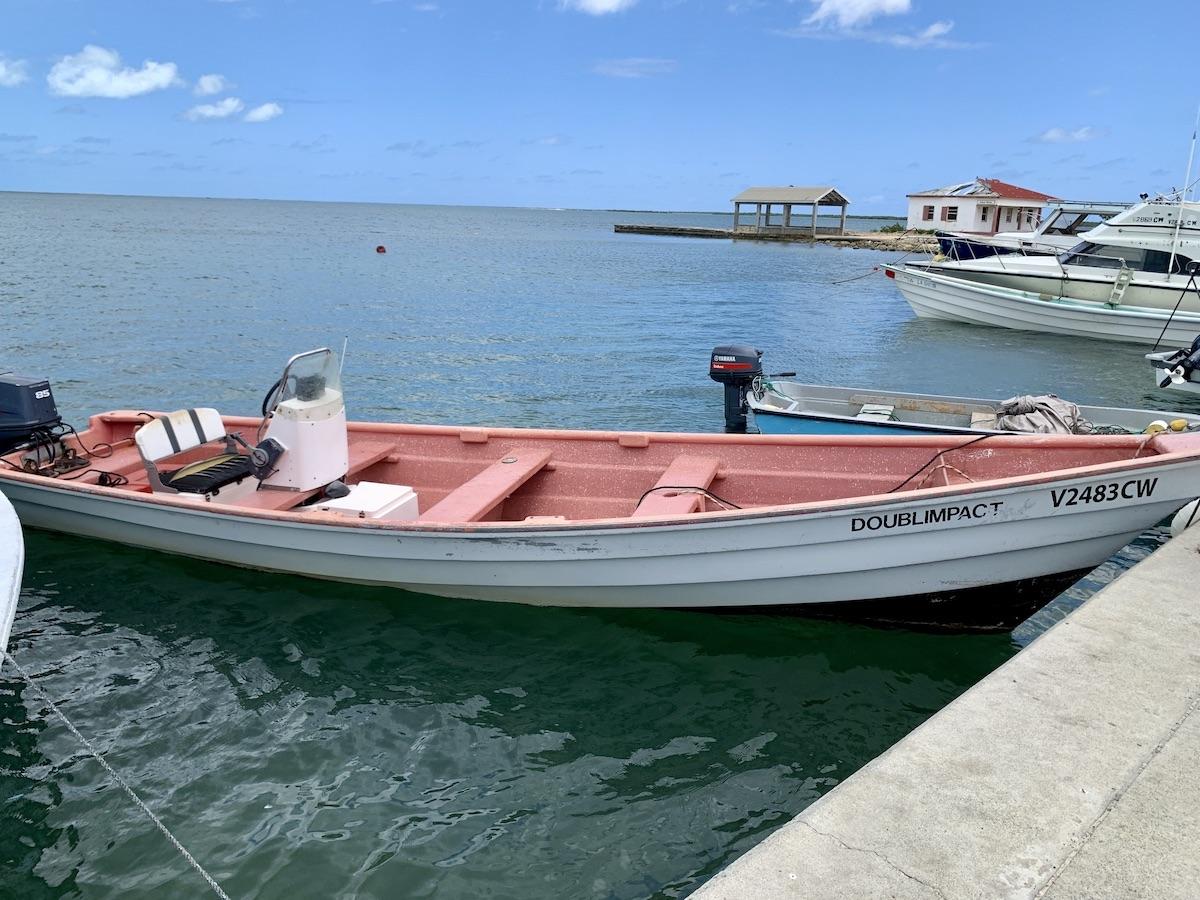
Doublimpact, the boat that takes us to the frigatebird sanctuary/Jennifer Bain
“Welcome to Barbudaful,” driver Devon DeSouza says before showing off the town of Codrington’s three schools, churches, sporting complex, post office and small hospital. Tourism, he allows, is the island's main industry, followed by construction now that sand mining has been depleted.
DeSouza zips us out to Two Foot Bay National Park — which isn’t marked by any signs — where tour guide Calvin Gore then leads a two-hour hike to Darby Cave.
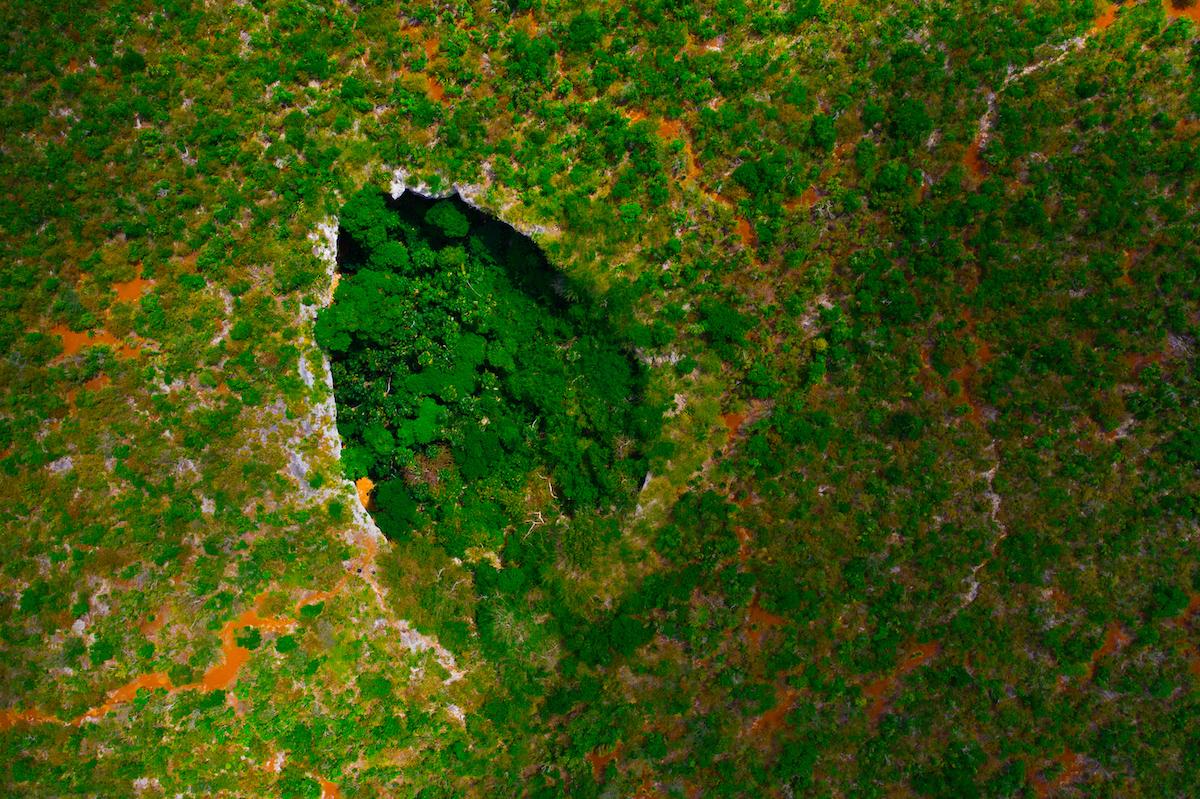
Darby Cave is actually a vegetation-filled sinkhole in Two Foot Bay National Park/Antigua and Barbuda Tourism Authority
The cave is technically a vertical-sided sinkhole in the middle of the woods. Filled with palm trees, ferns and lush vegetation, it’s about 350-feet wide and 70-feet deep and celebrated as a “mini rainforest” that shelters hermit crabs, land turtles and even fallow deer.
What’s really interesting is when Gore stops along the trail to show off balsam leaves (it oozes a liquid that can treat scrapes and cuts) and turpentine trees, and points out the song of the tiny but active bananaquit bird. Antigua and Barbuda's national flower — dagger Log (Agave karatto Miller) — sports dramatic yellow flowers that rise from the large rosette formed by the Agave plant. Fishing rafts were once made from the flower's log (or stem) and fishing bait was made from the white interior pulp of the leaves.
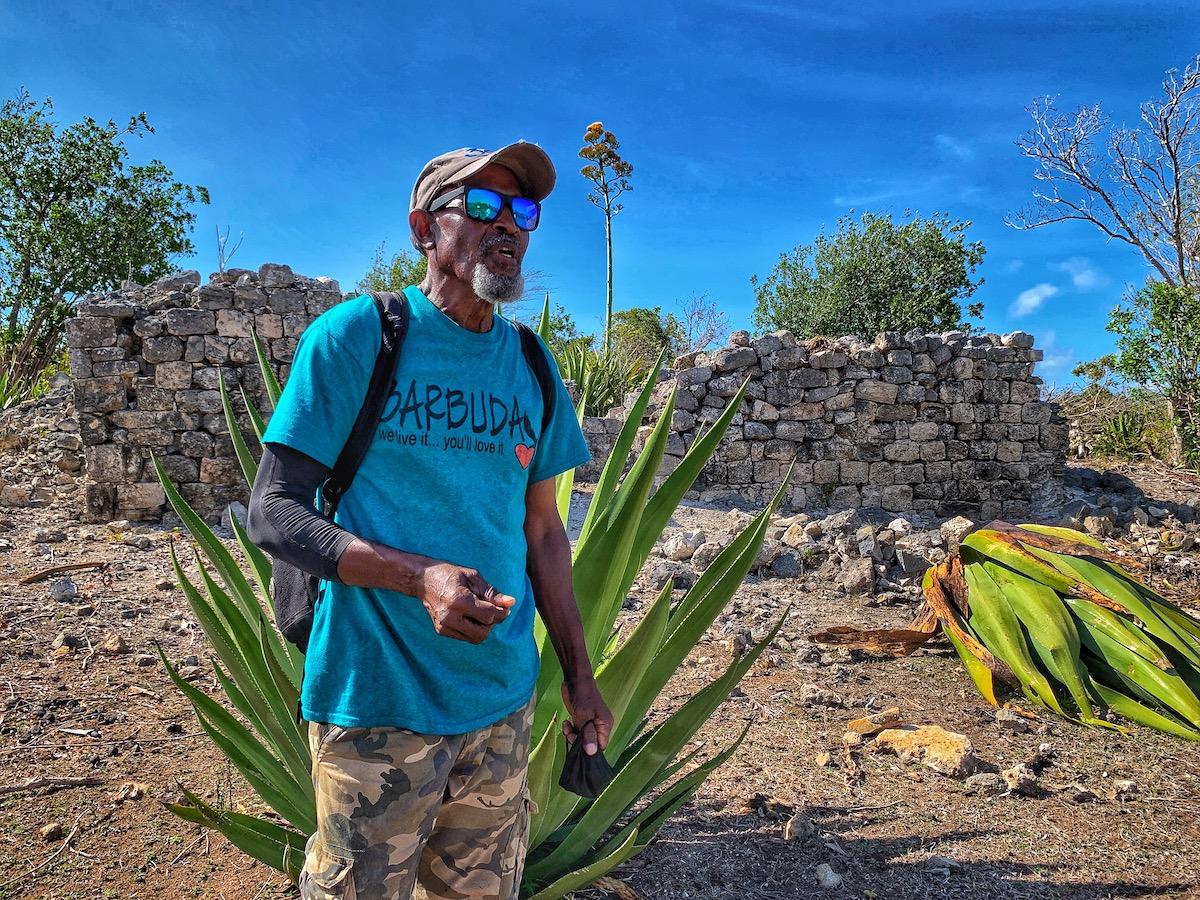
Barbuda tour guide Calvin Gore at Highland House ruins/Jennifer Bain
The trail to the cave begins and ends at the Highland House ruins, built by the Codrington family in Barbuda’s “highlands” and used as a hunting lodge, country residence and spot to watch shipping and shipwrecks.
There’s time for a takeout lunch from Uncle Roddy’s at Barbuda Cottages, but not enough time to visit the new Nobu Barbuda restaurant on Princess Diana Beach. The restaurant is the first step in a plan by Hollywood star Robert De Niro, who has long loved Barbuda, and billionaire businessman James Packer, for a luxury resort called Paradise Found Nobu on leased land on what was once the K-Club resort. The people of Barbuda have gone to the Privy Council in London to challenge the lease in a fight to maintain communal land ownership.
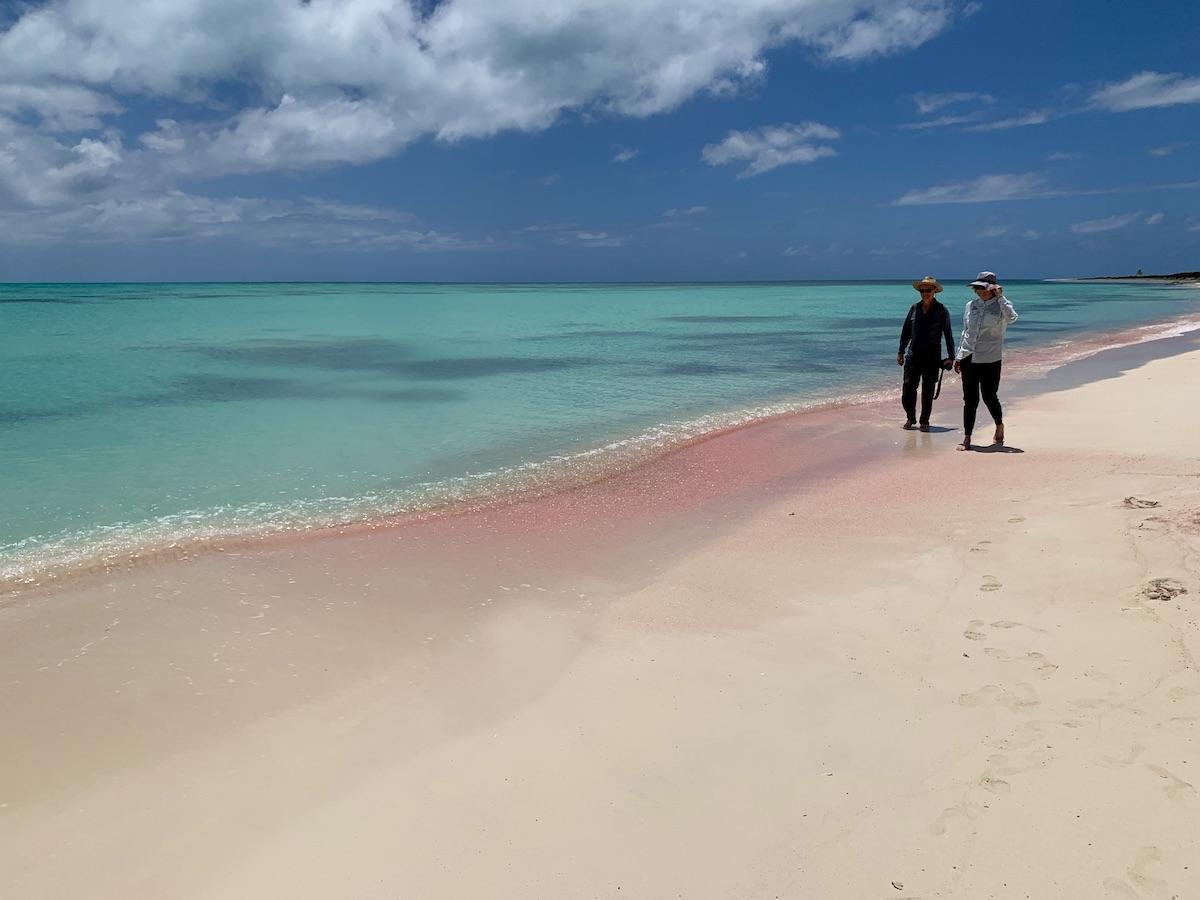
After seeing the frigatebird sanctuary in Codrington Lagoon, don't miss Pink Sand Beach/Jennifer Bain
But we don't need Princess Diana Beach — so named in 2011 after the late princess's four visits to Barbuda — because we get to visit an even more remote one near the frigatebird sanctuary.
“This is good,” says Nibbs after we stay a little longer than the allotted 15 minutes at the frigatebird sanctuary, “but the Pink Sand Beach is a sight to behold.”
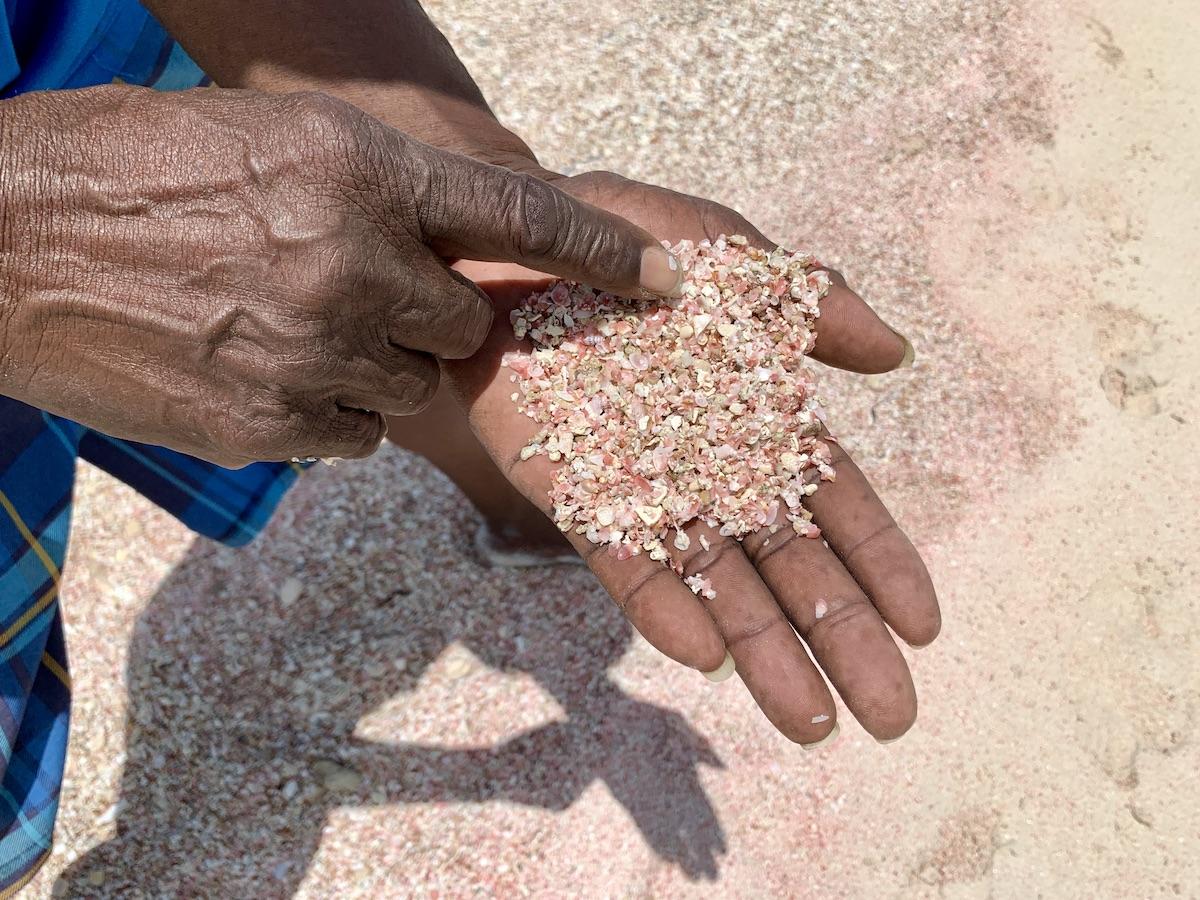
Barbuda tour guide Clarence Nibbs shows off the tiny shells that give Pink Sand Beach its name/Jennifer Bain
He zips over to the western edge of the lagoon and lets us hop out into the shallow water and cross a narrow patch of land.
Pink Sand Beach, which brings the tour cost to $60, is everything Nibbs has hinted at and more. The "sand" really does have a distinctive pale pink hue that's caused when millions of tiny, pink shells wash in, he explains. The ocean here, just steps from the murky lagoon, is that brilliant shade of turquoise that doesn't seem real. There are no chattering frigatebirds, or other humans, to be found so we revel in a few exquisite moments of solitude.
When we reluctantly trudge back through the lagoon to the boat, a feisty blue crab ushers us away, his claws waving madly and his tiny face expressing major annoyance at the intrusion. This time, the boat keeps its distance from the sanctuary, so all we see is tiny black specks floating in the wind above the mangroves.

Comments
Excellent article and photos! Will definitely be addIng Barbuda on our list of places to visit next.